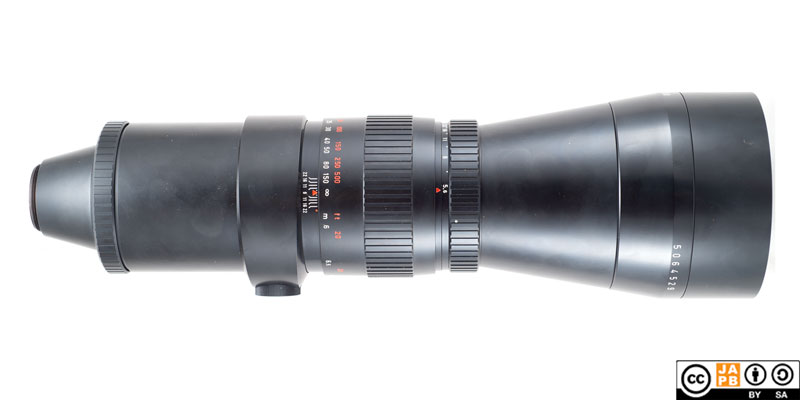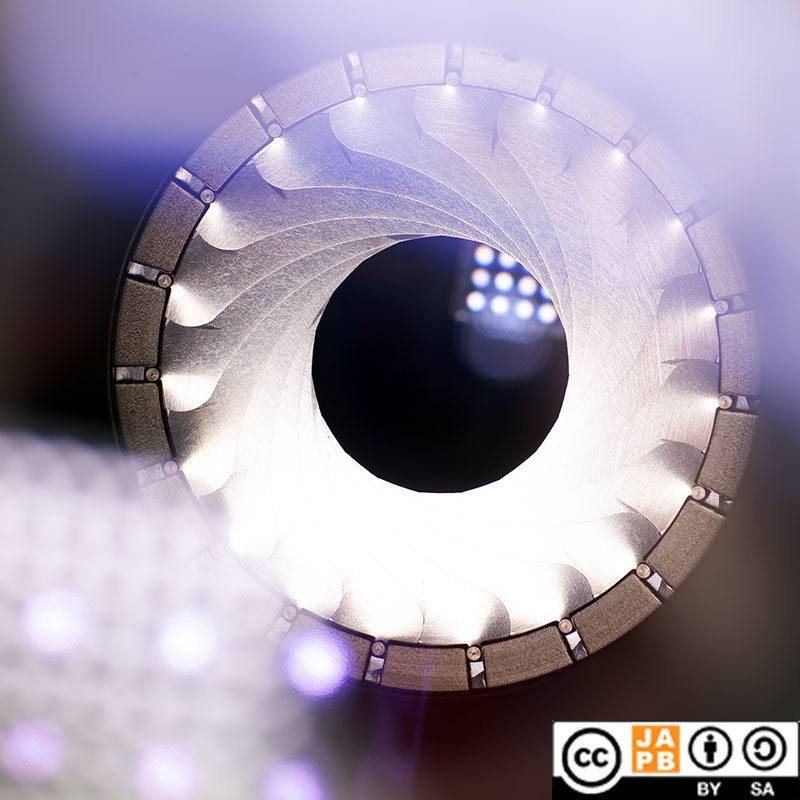Pekka Buttler, 04/2024

Specifications
The table below summarises the lens’ key specifications (measurements based on above pictured sample):
| Brand: | Pentacon | Lens name | 5.6/500 |
| Focal length(s)1 | 500 mm | Angle-of-view2 | 5 ° (on full frame) 10° (on medium format) |
| Maximum Aperture | f/5.6 | In Production | 1965-1990 (all versions) |
| Lens mounts | m42 | Other lens mounts | Exakta, Pentacon Six, Praktina, Praktica B, T2 |
| Length3 | 431 mm | Diameter4 | 125 mm |
| Filter ring diameter | 118 mm | Weight | 3430 grams |
| Lens element count | 4 | Lens group count | 4 |
| Aperture blades (S/R/C)5 | 19 | Focus throw | 330 ° |
| Minimum focusing distance | 6 m | Maximum magnification | 1:≈10 |
| Has manual aperture ring | YES | Has Manual focus ring | YES |
| Aperture mechanism type | Preset | Aperture click stops | None |
Further notes:
• This lens was produced over 35 years, and under that time it had many names (rough production dates in parentheses):
– Meyer-Optik Görlitz Orestegor 500 mm f/5.6 (late 60s)
– Pentaconar6 500 mm f/5.6 (early 70s)
– Pentacon 500 mm f/5.6 (early 70s–mid 80s)
– Pentacon Prakticar 500 mm f/5.6 (late 80s)
– Meyer-Optik7 500 mm f/5.6 (early 90s)
• All versions (Meyer-Optik Görlitz/Pentaconar/Pentacon/Prakticar/Meyer-Optik) of this 500/5.6 were preset aperture lenses featuring an aperture range of f/5.6–f/22 and a 19-blade aperture mechanism. The Preset mechanism could be set on a half-stop interval between f/5.6 and f/22.
• This data sheet addresses the Pentacon 500 mm f/5.6 lens but specifications for the Meyer-Optik Görlitz Orestegor 500/5.6 and Pentacon Prakticar 500/5.6 are almost identical.

• Alike many tele lenses designed in the 1960s by Meyer-Optik Görlitz, the Pentacon 500/5.6 used Meyer-Optik’s proprietary interchangeable mount system, and was therefore theoretically usable on a wide range of cameras:
– the initial Meyer-Optik Orestegon 500/5.6 as well as the early Pentacon 500/5.6 lenses could be purchased with a mount for either Exakta, M42, Pentacon Six or Praktina mount cameras
– from roughly the early 80s, the lens was also offered with mounts for the Praktica B mount.
– for a short while in the 1990s, you could also buy the lens with a T2 mount.
– because the interchangeable mount parts are relatively simple, any competent machinist is able to produce a mount for any full frame (or smaller) camera mounts, while some medium format (film mounts) are impractical due to adverse flange focal distance differences.
• This lens is something of an oddity, because it seems it was primarily designed as a long tele lens for the Medium Format Praktisix (later ‘Pentacon Six’) camera. The requirement for being able to comfortably cover medium format film (≈80 mm diagonally) has been defining for the designing of the lens. Hence, for use on full-frame or 35 mm film, the lens is somewhat over engineered.
Versions
This lens remained in production for ≈35 years. During that time, no changes to the basic optical recipe were made, but in the mid 70s lens elements started receiving multi coating. Your lens will have multicoating, if:
– its name sports the MC acronym.
– it is branded as ‘Prakticar’
– if it is branded ‘MEYER-OPTIK’, in all caps (Not ‘Meyer-Optik Görlitz’)
During that 35 year production period, some cosmetic/ergonomic changes also happened:
– the focus ring patterning changed, first from a ridges and valleys type to the lengthwise ribbed pattern (pictured above); then the lengthwise ribbing elongated to broaden the focus ring grip.
– similarly, the initial aperture ring featured a very narrow ribbing, but that changed to the design pictured above.
– the colour of the feet scale was changed from orange-red (as pictured) to green.
• While by no means rare, this was never a high-volume lens. Hence, it’s quite possible to find lenses that combine barrel parts across variations.
History of Pentacon
There is little doubt that Germany was once world leader in the designing of cameras, lenses, and pretty much anything else photography related. Moreover, within Germany (pre-WWII Germany, to be precise), there was a region along the middle of the river Elbe and its tributary the Saale that would have earned the moniker Silica Valley. Just like the modern Silicon Valley, this area was a powerhouse of innovation within the still nascent photo-optic industry, housing both a plethora of camera makers, lens makers, and other, supporting industries. Optics was a booming industry, and even wars did little to change the industry’s growth trajectory.
But after the Second World War and the ensuing uneasy peace between the Western Allies and the Soviet Union, Silica Valley – residing in the modern German states of Thuringia and Saxony – ended up in the Soviet Zone of control, that – as tensions between erstwhile allies grew – developed into the ‘German Democratic Republic’ or East Germany – a Soviet satellite state directly juxtaposed to the ‘German Federal Republic’ or West Germany.
The Soviet-inspired East German system had no love lost for private enterprise (which was seen as tantamount to a rentier-class exploiting the proletariat), nor for companies competing for customers (which was seen as a woefully inefficient method for allocating scarce resources). Hence, most enterprises were quickly nationalised, and competing companies were continuously being forcibly merged with their erstwhile competitors. One result of this policy was the 1964 founding of VEB Pentacon Dresden (VEB = Volkseigener Betrieb ≈ Peoples’ own enterprise).
VEB Pentacon was founded through the merger of
• VEB Kinowerke Dresden (formerly VEB Zeiss Ikon),
• VEB Kamera-Werke Niedersedlitz (previously Kamera-Werkstätten Charles A. Noble),
• VEB Welta-Kamera-Werk Freital (incl. VEB Reflekta-Kamerawerk Tharandt),
• VEB Altissa-Camera-Werk Dresden,
• VEB Aspecta Dresden.
As a result, the central planners in East Berlin had merged the majority (Ihagee, makers of the Exakta were left alone, for now) of East German camera makers into one giant company. The resulting Pentacon (the name is a portmanteau of ‘Pentaprism’ and ‘Contax’) however focused solely on manufacturing cameras, and instead sourced their lenses from East German lens makers (mainly Carl Zeiss Jena and Meyer-Optik).
But with the success – both domestic and international – of Pentacon cameras, especially the Praktica line of SLRs, Berlin seems to have considered tighter co-ordination to have been the the next order of business. Hence, in 1968 VEB Feinoptishes Werk Görlitz (which had managed to keep branding their lenses ‘Meyer-Optik’ even though such singling out of one person (Hugo Meyer) was against the Soviet creed) and Ihagee were merged into Pentacon, making the resulting Pentacon a fully vertically integrated colossus (or, in Soviet parlance, a combine.).
During the next two years, lenses previously having been branded Meyer-Optik Görlitz, started leaving their factory carrying the brand ‘Pentacon’ 8. Meyer-Optik had made some shrewd operational and design decisions, and in the post-war environment, characterised strongly by the proliferation of various SLR’s and other cameras (read: strong demand for lenses), MOG was having a field-day. Especially in the 1960s – just prior to the merger – Meyer-Optik was very prolific in coming up with new, cutting edge designs, so when Pentacon ‘took over’ Meyer’s lens catalogue, Pentacon was able to offer a broad range of cameras as well as lenses characterised by a very good bang/buck ratio.
While the merger worked wonders for Pentacon, the same can not be said for Pentacon lens designing. After having made immense progress in the 60s, Meyer/Pentacon lens design stagnated throughout the 70s and 80s. That is not to say that the lens lineup stayed unchanged, but that changes were either focused on minor recomputations of existing designs, economically driven simplification of lens mechanics, increased use of plastics, gradual adoption of better coatings and adoption of the Praktica B mount. It is sad to say that in the 20+ years after the Pentacon-Meyer merger, only one new lenses was introduced and only two lenses were given a major design tweak.
While I don’t want to give the impression that Pentacon lenses are generally sub-par (they were not, especially not when considering price), I am immensely saddened by the lost potential, especially considering the strides Japanese manufacturers were taking during that time. From Meyer having been at the forefront of innovation in the mid 1960s, Pentacon in the mid 1980s was increasingly the choice of only budget-conscious or ideologically inclined consumers.
Adapting
(Here we will discuss adapting this lens on the assumption that you have a version sporting the M42 mount piece. If you have another mount, look up the JAPB article on that mount)
This lens cannot be used natively on any current SLR or dSLRs. To use it in its native environment, you will need an m42-mount film body. Luckily there are a lot of those available and in working order.
Thanks to being a fully manual lens (manual aperture, manual focus), the lens can be adapted to all mirrorless cameras using a suitable adapter. Moreover, m42 lenses are so uncomplicated that a simple ‘dumb adapter’ will do the job perfectly. Further, due to the popularity of the m42 mount, special adapters (helicoid adapters, tilt/shift adapters) are readily available. Alternatively, one can choose to daisy-chain adapters (e.g. m42->Canon EF; Canon EF –> mirrorless) which also opens up a wide range of speed boosters .
Using m42 lenses on dSLRs can also be an easy option, depending on which dSLR.
• Canon EF has the shortest flange focal distance among full-frame dSLR’s and Canon’s wide range of dSLRs are able to mount m42 lenses perfectly, using a simple adapter ring.
• Minolta / Sony A dSLRs and Pentax dSLRs are likewise able to mount m42 lenses using a simple adapter ring.
• Nikon F dSLRs have a long flange focal distance, meaning that mounting M42 lenses needs an adapter that uses corrective optics to allow anything close to infinity focus.
Footnotes
.
- Focal length is (unless stated otherwise) given in absolute terms, and not in Full-frame equivalent. For an understanding of whether the lens is wide/tele, see ‘Angle-of-view’. ↩︎
- Picture angle is given in degrees (based on manufacturers’ specs) and concerns the diagonal picture angle. Rule of thumb:
> 90 ° ==> Ultra-wide-angle
70–90 ° ==> Wide-angle
50–70 ° ==> Moderate wide-angle
40–50 ° ==> ‘Standard’ or ‘normal’ lens
20–40 ° ==> Short tele lens
10-20 ° ==> Tele lens
5-10 ° ==> Long tele lens
< 5 ° ==> Ultra-tele lens ↩︎ - Length of lenses is USUALLY given on JAPB from the mount flange to the front of lens at infinity. However, as I was unable to unscrew this lens’ shortish lens hood, the number includes the lens hood. ↩︎
- Diameter excludes protrusions such as rabbit ears or stop-down levers. ↩︎
- S=straight; R=rounded; C=(almost)circular at all apertures. ↩︎
- During the period right after VEB Pentacon took over the lens catalogue of Meyer-Optik Görlitz, it would seem the new masters were not entirely sure how to name the new ‘Pentacon’ lenses. As a result, some early post-merger lenses left the factory sporting the name ‘Pentaconar’. ↩︎
- After the fall of the German Democratic Republic, the lens was even briefly offered under the resurrected Meyer-Optik name, at this time even an adapter ring to the T2-mount (42 mm threads with 0.76 thread pitch and 55 mm FFD) was included to broaden the lens’ appeal on then current systems. ↩︎
- • Pentacon 29/2.8 = Meyer-Optik 29/2.8 Orestegon
• Pentacon 30/3.5 = Meyer-Optik 30/3.5 Lydith
• Pentacon 50/1.8 = Meyer-Optik 50/1.8 Oreston
• Pentacon 100/2.8 = Meyer-Optik 100/2.8 Orestor
• Pentacon 135/2.8 = Meyer-Optik 135/2.8 Orestor
• Pentacon 200/4 (preset) = Meyer-Optik 200/4 Orestegor
• Pentacon 300/4 = Meyer-Optik 300/4 Orestegor
• Pentacon 500/5.6 = Meyer-Optik 500/5.6 Orestegor ↩︎